
Roger
This peaked my interest when I noticed the Rotary Maleny decal on the tractor.
It’s a bit long and sits behind a paywall; but maybe you can just include the first few paragraphs
Also great talk this morning, really enjoyed it.
Thanks
Mark
- From The Weekend Australian Magazine
October 2, 2021
- 14 MINUTE READ
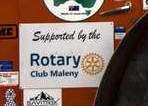
Good spotting Mark
The roads to freedom are paved with travellers. They’re an eclectic bunch, often roaming in vans, with enormous tracts of the continent and endless coastline at their disposal as they move from iconic location to picture-perfect sunset mid-pandemic. The national gates may be closed, but that hasn’t left everyone confined.
From remotest Queensland, across the Northern Territory and through Western Australia, the roads may be less travelled but there are still sightseers out there. While parts of the country wither, some traditionally quieter areas are brimming with travellers who are confined only by border closures and the odd, invariably short-term lockdown. Over the past year, visitor numbers to outback Queensland have exceeded projections by almost 40 per cent, according to the Outback Queensland Tourism Association. And earlier this year the nation recorded its busiest quarter on record for camping and caravan trips – the NT, Queensland and WA all notched up record monthly occupancy in tourist parks in July.
While millions of people in some states have been homebound, others have been on the road, often for the sheer joy of discovery, but sometimes by necessity. And it has led to an unexpected phenomenon. Journeying through Australia in a time of Covid, the ability to explore huge parts of the country seems to have transformed from a rite of passage to a deeply cherished privilege.
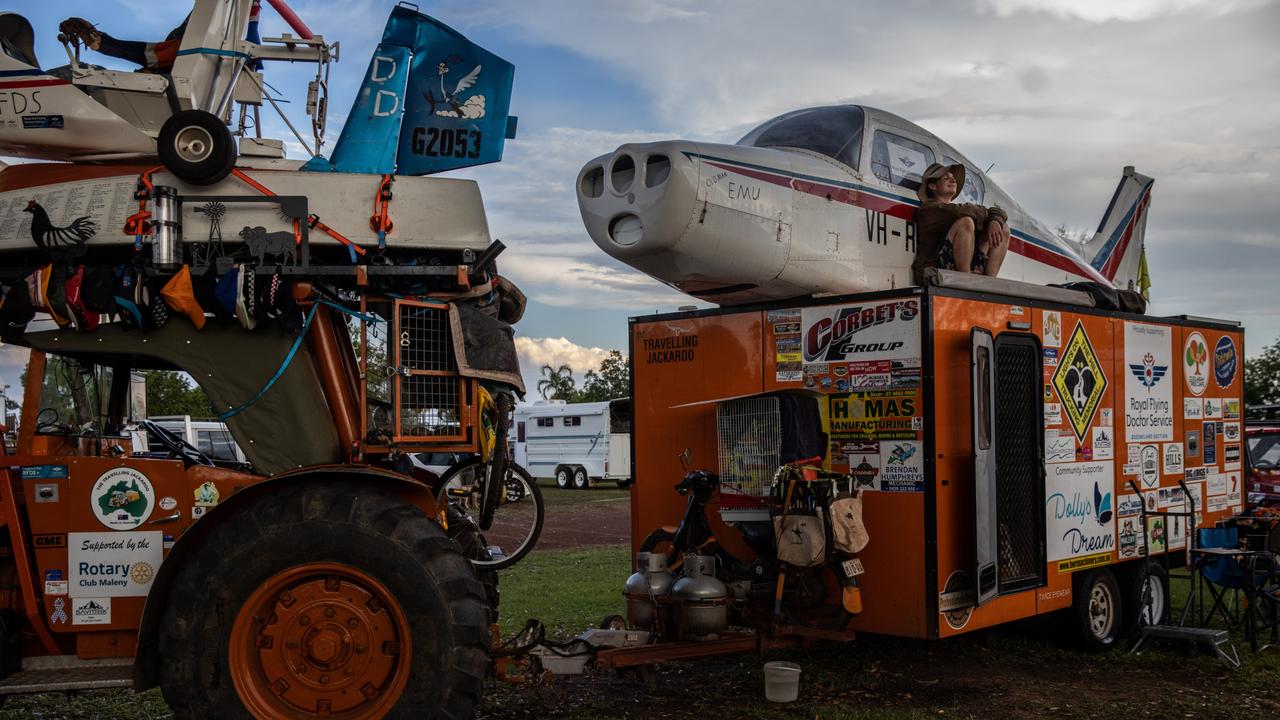
Sam Hughes and his colourful one-man convoy in Darwin. Picture: Helen Orr
A man and his dog are heading for Darwin. They’re on a long, slow trip that has so far taken half a year and spanned 6000km, from the Sunshine Coast to the Top End via rutted roads, remote settlements and vast outstations.
There are so many standout features on their unlikely adventure: the fact that it is even happening during a pandemic; the fact that Sam Hughes, who is accompanied by his beagle-kelpie cross, Bitsa, is just 18; and, perhaps most significantly, the fact that they are undertaking this journey, which Hughes hopes will become a two-year circumnavigation of the continent, on a 60-year-old tractor.
“I’m used to being overtaken,” laughs Hughes, who has a knack for acquiring multiple modes of transport. A freshly minted driver, he has red P-plates affixed to the back of a trailer hitched to his old tractor to form a colourful one-man convoy. Travelling light is not for Hughes. His extensive and eclectic load includes a cockatiel, a boat and a gyrocopter that travel on a rack atop his tractor, plus – in or on his trailer – a small car, a motorbike, a wingless light aircraft in which he sleeps most nights, a bike, a portable cinema, a jumping castle and a popcorn machine.
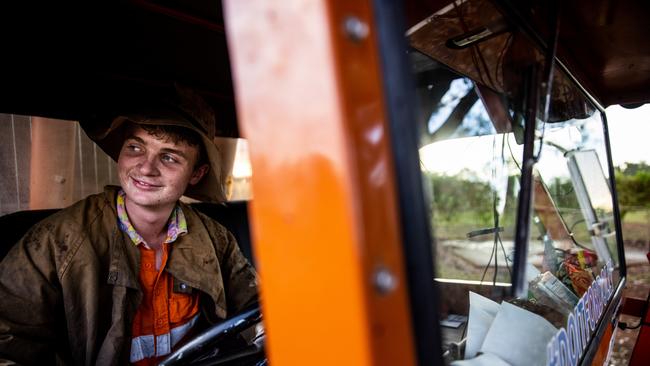
Sam Hughes. Picture: Helen Orr
He has been on the road since leaving his family’s 120ha cattle property at Maleny, in the Sunshine Coast hinterland, in March. “I like helping people and I was too stupid to be a doctor,” he says drolly when asked about the inspiration for his trip. “I didn’t have the guts to be a police officer… and I thought, well, if I want to do a gap year and I want to help people, the best way I can do it is by supporting charities.”
He initially planned a drive to Toowoomba, a 200km-odd journey that would have taken him just a few days on his preferred mode of transport. “I can work with a tractor better than I can a car,” he says, having tinkered with the former for almost five years, compared with the few months he’s had a licence to drive the latter. So he bought a 1960 Chamberlain 9G from a neighbour and spent a year modifying it; new canvas and a four-inch foam-core seat were about the biggest luxuries he could afford. By the time he was ready to leave home, his plans had expanded and for next to nothing he had acquired a small if ageing transport fleet to make his progress even more visually outstanding. “There are no computers in any of my vehicles,” he says proudly. “That means if it breaks you can fix it with duct tape or zip ties.”
At an average speed of 35km/h, his progress is slow and low-tech. He has a VHF radio, but no airconditioning or power steering. And with all the rattling in his cab it can be hard to hear the Slim Dusty songs he plays, full blast, on a journey that has so far taken him to Barcaldine and Longreach, along the coast to Rockhampton, Cairns and Townsville, inland to Charters Towers, Cloncurry and Mount Isa, and up through the Red Centre via Tennant Creek and Katherine to Darwin.
He sometimes picks up work en route, helping out at a local pub for a shift or two. Often, to raise funds, he sets up his outdoor cinema or jumping castle for locals. In half a year he has already raised $50,000 for his three favourite charities: the Royal Flying Doctor Service, anti-bullying group Dolly’s Dream and Drought Angels.
“Out here doesn’t seem to have changed much because of Covid, just a QR code as you go in,” he says at the end of another seven-hour drive, during which he encountered fewer than 30 vehicles on the Northern Territory’s big open roads. So far he has managed to avoid lockdowns, bar a few days in Townsville.
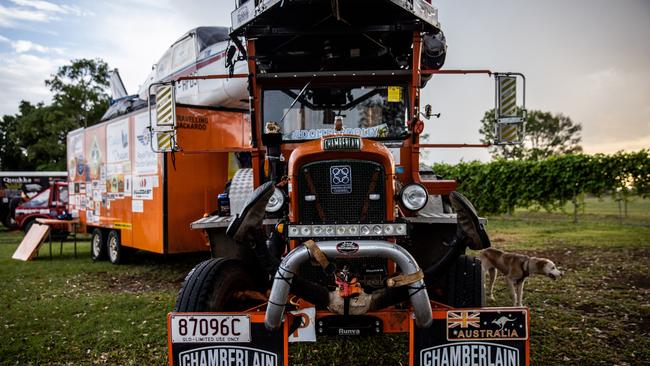
Picture: Helen Orr
While driving a tractor around a largely shuttered country has its disadvantages (“of course it’s lonely”), he has been overwhelmed by the welcome he has encountered. He’s been unsettled, too, by the breadth of mental health issues and lack of local support services. Many times Hughes, the 18-year-old outsider, has found himself listening for hours to the harrowing stories of those struggling to access psychiatric help for children or recounting yet another story of suicide. “I feel very privileged with what I do because not only do I get to see the country but I hear so many stories,” he says. And he has been astounded by the scenery. “When you’re cruising along at 35km an hour you get to see the country change. It’s the most amazing thing to see the underbrush go from a yellow to a beautiful green, and the trees.”
But of all the standouts of his unlikely gap year, there is one incident on which Hughes is extra keen to report. “The most proud moment of this entire trip, and I think it will be until the day I finish, was the day I overtook a grey nomad,” he reveals with enormous satisfaction. “Coming out of Roma, I was cruising down the highway and up ahead I’ve seen this big white box sitting in the middle of the road.” He soon realised it was not in fact stationary, but moving – very slowly. To Hughes’ astonishment, a couple in a mobile home were proceeding through southwest Queensland at an even slower pace than a tractor.
“And I’ve just gone, ‘Holy heck, you’ll never get a chance like this again’. Twenty metres away, I’ve floored it – 42km an hour – and I went past them, like I was jogging, and waving like hell.” After months of being repeatedly overtaken, he was ecstatic. Victory, however, was short-lived. “About two seconds later they miraculously found their throttle – and went past me at 80km an hour.”
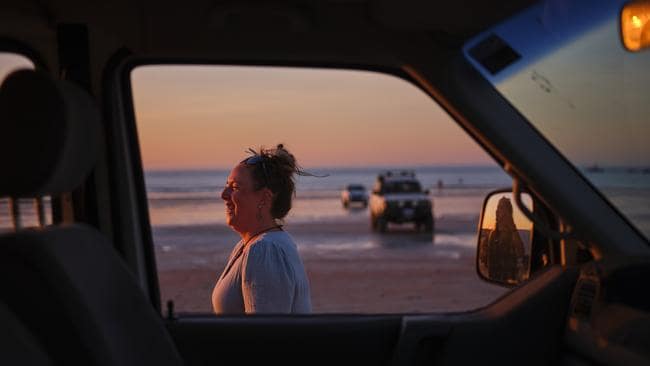
Stacey Williams in Broome. Picture: Duncan Wright
At 39, Stacey Williams has spent much of her adulthood travelling, at first for pleasure and, for the past three years, professionally, as a tour guide leading trekkers through some of the most spectacular expanses of Australia. “Pretty much my life has revolved around travelling for 10 years now. I worked so I could travel overseas and now I have a job where I get to live in holiday-land,” she says from her temporary home in Broome. “I travel all around Australia, different seasons in different places.” With reassuring regularity, she has led groups through Tasmania’s Central Highlands, along the NT’s Larapinta Trail, through South Australia’s Flinders Ranges and all over WA. In early 2020, she was midway through a trek in Victoria’s High Country when the pandemic exploded. “We had people from interstate that needed to get home by the next day. So we had to get them to the airport,” she says of that mad dash from somewhere beyond Mansfield back to Melbourne. “Then I went home not knowing what came next.”
For six months Williams remained at home, aided by JobKeeper, and kept busy for some of the time by upgrading her company’s training manuals. Her professional future, like that of so many others across multiple industries, was uncertain. Then, to her utter joy, in spring last year she was approved to resume tours through WA. After quarantining for a fortnight, she found herself on the Cape to Cape track in the state’s south-west, trekking past pristine beaches and soaring cliffs. After a brief return home to Melbourne, some of the old patterns of her working life resumed. In January she returned to Tasmania, guiding travellers through the Bay of Fires, along the east coast, to Bruny Island and through the Central Highlands, which took her through to April.
While others feared to leave home, her job meant she could keep travelling: she went to South Australia, and then from early June she led trekkers through the NT to Katherine, Litchfield National Park and beyond. The pandemic’s implications still shadowed her: she had to produce bank statements to gain entry into WA, and in many parts “my ID from Victoria has raised a few eyebrows”, she says. Yet, surrounded by nature in some of the quietest regions of the country, she could temporarily forget such concerns. “On a tour, hiking out in the middle of nowhere without reception, you can pretend it doesn’t exist, and it’s really, really nice for a few days.”
In a time of so much uncertainty, luck and timing have been two of Williams’ most reliable travelling companions. Part of her success in moving so widely is that she has mostly toured states when they have had minimal if any viral transmission. While many touring groups have been smaller than usual, “it wasn’t too bad. This year has been relatively OK,” she says. “Until recently.”
When her season in the NT ended in August, she was confronted with a dilemma. She could return home to Melbourne after many months to see her family and friends. But if she did, given the city’s lockdown, she had no idea when she could leave – or work – again. If she stayed away, she might yet be able to work the next season in Tasmania starting in November, but at the cost of not seeing her loved ones for almost half a year. “Part of me really wanted to go home and see my people because I hadn’t seen them for so long. But then the possibility of being stuck there for an unknown amount of time and not being able to work led me to make the decision to go to WA.”
With a couple of months of free time until her next job, Williams opted to further explore the nation’s biggest state. But even that wasn’t straightforward. Having recently been in South Australia’s Flinders Ranges, she was unable to enter WA immediately. So she spent an extra fortnight in Alice Springs and then in late August, instead of heading home, she flew across the continent to Broome, where, armed with a tent and a sleeping bag, she began her extended stay in the state.
So is she stranded or on a holiday? “It’s probably holiday, but it was hard to get my head around,” she says of her unusual predicament. “All your work has been cancelled, you can’t go home, you can come here. Part of you is a bit stressed: ‘What am I going to do for money?’ The other part is thinking, ‘Well, I’ve got some time off, how can I make this amazing?’ You’re in the middle of feeling happy and excited and a little bit scared of what the future might hold.”
After several weeks in Broome, where her company was able to access some increasingly scarce accommodation, she opted to seize the day. She and a colleague have bought a van and are heading for new territory – Williams’ latest bucket list includes Ningaloo Reef and the Pilbara. Far from home, with no work for months and on an extended break by necessity, she considers herself lucky. “Because I know what they’re going through, being stuck in lockdown,” she says from her latest patch beside a glorious stretch of the Indian Ocean, where an endless blue sky merges with rich red earth and golden sand. “I had that last year and I know how terrible it feels.”
Pandemic? In the eight months they have been touring eastern Australia, Ella Press and Ryan Thomson have amassed a sightseeing scorecard that would be enviable in the best of times. While millions have had their worlds reduced to a 5km radius, Press and Thomson have sailed the Whitsundays, explored tropical islands, enjoyed the soothing waters of a hot spring in outback Queensland and hiked through national parks. Between swimming in waterholes and strolling on palm-strung beaches, they’ve even been upgraded on paid excursions because the tours still running have had comparatively few people attending.
“We have no itinerary. We just wake up in the morning and decide where we’re going that day,” says Press, 21, from the couple’s most recent stop at Trinity Beach in far north Queensland. Since leaving Sydney in February they’ve covered much of the coast north to Cairns.
Their travel story began pre-Covid, and far from Australia. In May 2019, when certainty was still an assumed factor in the plans of many backpackers, Press left New Zealand for a months-long trip to Asia and Europe. She met Thomson, a Sydneysider, in Krakow, Poland. He was planning to live in Europe and had lined up some pub work in Ireland, but after meeting Press he discarded his plans and the couple spent the next six months exploring Europe together.
Late that year, Press returned home temporarily to earn some more travel dollars. But before she could resume her overseas jaunt, Covid struck. With international borders shut, she was stuck in New Zealand and Thomson, who had also returned home, could not leave Australia. “It felt like we had no end in sight. We just didn’t know if we were going to see each other in the next year or so,” Press recalls of those interminable months, during which Thomson’s repeated applications to join his girlfriend in New Zealand were denied.
From her Wellington home, Press also kept seeking permission to be with her boyfriend in Sydney. On her ninth attempt she was successful. She arrived in Australia in October, and over summer the pair worked casual jobs to fund their reshaped travel plans. “I had always wanted to do Australia in the future,” says Thomson, 23, of his decision to explore his home. “It was always one of my plans but I thought it would be after I retired when I was a lot older. I’d just thought, ‘Get out of Australia and see as much of the world as I can while I’m still young’.”
The pair left Sydney in a Ford transit van at the end of February, planning a half-lap of the mainland, heading to the tip of Queensland, across to the NT, and down through the Red Centre. “We figured that the international borders would be closed for a long time and we should make the most of it,” says Press. “Once we left we thought, ‘This is actually great, how would we go back to work?’”
For weeks they meandered along the coast of Queensland, where they were thrilled to discover that clubs were still open, until they reached Rockhampton. When they tried to renew their van’s registration there, a mechanic produced a long list of required repairs. “Ridiculous things,” says Press, “like a slight bit of fraying so we would have had to replace the whole seat.” Instead, they drove straight back to NSW, and spent a few weeks in Tweed Heads, where their vehicle was quickly reregistered. They took another fortnight to fly to New Zealand and meet Press’s new niece before resuming their drive at the Gold Coast, this time taking the inland route back to Rockhampton.
With their home on wheels, for eight months they have mostly remained in Queensland and have so far avoided lockdowns; when Cairns was temporarily shut down, they instead headed for the World Heritage-listed Cape Tribulation region. Thanks to free camping most nights, and plenty of savings, they have only just started looking for work picking fruit. While others are consumed with the pandemic, their biggest concern is the weather, and the possibility of being confined to their van for long hours during a storm.
Given the anxiety that has settled over so much of the country, both are keenly appreciative of their independence. “We are so, so lucky,” says Press. “All of our friends and family back in Sydney keep on messaging us to say how jealous they are. Whereas we could drive anywhere we want. We’re having this extraordinarily long holiday while everyone is locked down.”
Or as Thomson concedes: “There is a bit of guilt there... but someone’s got to do it.”





